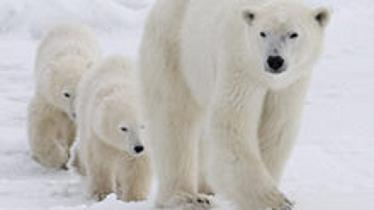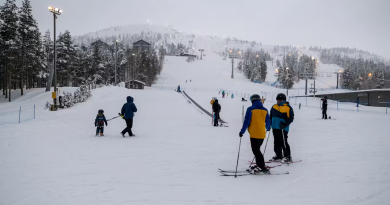Polar bears increasingly coming ashore in Arctic Alaska

By Yereth Rosen, Alaska Dispatch
Piles of bowhead whale bones and blubber left on an Arctic beach by North Slope hunters may be emerging as an important winter food source for the region’s beleaguered polar bears, according to a new study.
In the winter of 2010-11, more than 200 polar bears gathered at the pile of bowhead whale bones left on the beach of Point Barrow — in Alaska’s far, far north — following the local fall subsistence hunt, said the study, published online in the current issue of the scientific journal Ursus and authored by North Slope Borough and U.S. Geological Survey biologists.
Some of the bears are sniffing and crunching bones, which have little caloric content, but the big prize is the raw blubber that is that is left behind after villagers have cut up meat and slices of whale skin layered with fat known as muktuk, said study co-author Jason Herreman. The blubber is “what the bears are really going for,” said Herreman, who worked for the North Slope Borough during the study and is now with the Alaska Department of Fish and Game.
The study relied on samples of hair snagged by barbed wire set up strategically around the bone pile from November to February that winter. From the hair samples, the scientists identified 97 specific bears; using genetic analysis, they calculated that 228 dined at the bone pile over the study period.
That number is equivalent to 15 percent of the Southern Beaufort Sea polar bear population, the authors said.
Related slideshow: Polar bears gather in Kaktovik to dine on bowhead whale remains
Whether the bears frequenting the Barrow bone pile are actually from the Southern Beaufort population is yet to be determined, Herreman said.
He said he suspects that they are mostly from the Beaufort population rather than the more robust Chukchi population, but discovering the identities of the bears taking advantage of the bone pile is only one of several subjects for continued research on Alaska polar bears’ apparent increased reliance on bowhead-whale leftovers.
“Is it the same bears coming back year after year?” he said. “How important is that food source to the bears that are coming onshore?” And what is the significance of the behavior?
The study published in Ursus is part of a larger USGS-North Slope Borough program examining polar bears’ increased presence on land in Arctic Alaska, including their habit of loitering around bowhead-whale scrap piles. There are three major locations where the piles regularly accumulate after fall hunts — Point Barrow, the subject of the new study; Cross Island; and a site outside of Kaktovik, hundreds of miles to the west of Point Barrow. A record 80 bears congregated near that latter community in September of 2012 to feast on the remains of a bowhead there.
Signs so far are that the onshore scavenging is linked to reduced sea ice.
While bowhead hunts have been conducted for centuries on the North Slope — along with the resulting accumulation of bowhead bone piles — the phenomenon of regularly-timed piles appearing on the beach is relatively new, Herreman said. In the past, fall hunts were conducted from ice, and butchering was performed there as well. Whale scraps left on ice floated away and eventually wound up in the water, Herreman said.
That fall ice is now largely gone. Open water means better seasonal whale-hunting opportunities from shore and near-certainty — from the bears’ point of view — of a blubber-coated carcass appearing on the beach at the same time as bears move toward land and that sea ice recedes farther from shore.
“It’s kind of like the perfect storm of events,” said Todd Atwood, a USGS scientist working on related polar bear projects.
A Beaufort phenomenon
Signs are this is more of a Beaufort phenomenon than a Chukchi trend. Research so far shows that the southern Beaufort polar bears are in significantly worse shape than their Chukchi counterparts to the east. While Southern Beaufort Sea polar bears are smaller, hungrier and less likely to successfully reproduce — problems attributed to reduced sea ice coverage over the shallow continental shelf — the Chukchi bears have so far been able to largely withstand a steady loss of ice coverage in their part of the world, according to a USGS study published in the journal Global Change Biology.
The Chukchi Sea is a more biologically productive area than the Beaufort, with a much vaster continental shelf that makes for more shallow offshore waters. Declines in ice coverage in the Chukchi have also lagged behind similar losses in the Beaufort, Atwood said. As a result, the forces driving Beaufort polar bears onshore are not as prevalent in the Chukchi, he said.
Onshore presence of Southern Beaufort Sea polar bears has increased since 2009, compared to just a few years ago, according to findings Atwood presented Monday night at a poster session at the week-long Alaska Marine Science Symposium in Anchorage.
While only 4 percent of the southern Beaufort Sea polar bear population spent part of the summers between 2000 and 2004 onshore, that proportion is now up to 18 percent, Atwood said. The bears are arriving earlier than they did a decade ago, in July instead of early September, he said. They are staying longer, he said, with an average stay of 40 days, compared to the typical week-long stay for the few polar bears that ventured onshore in the late 1980s and early 1990s.
For polar bears that are already on shore by midsummer, there may be an increasing expectation that enticing bowhead scraps will appear each September, Atwood said.
Yet unknown is whether the bone-and-blubber scavenging is good for the bears.
The biggest bear congregations are around the bone piles outside of Kaktovik, and the animals dining there seem to be prospering in comparison to other Southern Beaufort Sea polar bears. Herreman said.
“They’re fattening up pretty readily and they’re getting a jump into the winter season,” Herreman said. “Is this an argument for keeping bone piles around rather than trying to get rid of them?”
But even if the whale-hunt leftovers are good for polar bears in the short term, what about the long term? Atwood said he has his doubts.
There may be too many bears congregating, he said. “They might outstrip the resource,” he said. Close crowds of polar bears — “animals that aren’t particularly gregarious or social” — might create new problems, like the spread of disease among bears and possibly into other animal populations, he said.
And there are nagging concerns about community safety, both Atwood and Herreman said. Bigger groups of polar bears spending more days close to humans means increased likelihood of bear-human conflicts, they said.
Contact Yereth Rosen at yereth(at)alaskadispatch.com



